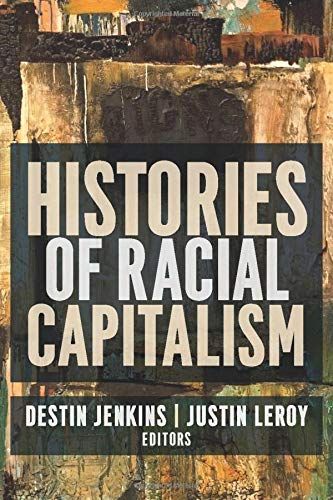History professors Destin Jenkins and Justin Leroy present a wide-ranging, eye-opening collection of essays detailing how capitalism has historically served as an engine of racism.

Profit and Race
Destin Jenkins, assistant professor of history at Stanford, and Justin Leroy, assistant professor of history at the University of California, Davis, and the codirector of the Mellon Research Initiative on Racial Capitalism, have edited a thought-provoking collection of scholarly essays that reveal how racial oppression has informed capitalism through the centuries. The essays explain how economic interests dispossessed racial minorities of wealth through financial innovations such as foreclosure, and how these injustices persist to the present day. This eye-opening chronicle of race and capitalism will engage anyone interested in history, economics and contemporary politics.
The System Endures
Federally recognized Native American tribes, because they were a sovereign people before the United States existed, enjoy rights in the US political and economic spheres. The Supreme Court approved employment preferences for Indigenous Americans on the grounds that their identity is political, not racial. But this obscures the racial dimension of anti-Indigenous measures and frustrates Black demands for wealth redistribution, including reparations for slavery.
Racial capitalism is the process by which the key dynamics of capitalism – accumulation/dispossession, credit/debt, production/surplus, capitalist/worker, developed/underdeveloped, contract/coercion, and others – become articulated through race.editors Destin Jenkins, Justin Leroy
Economics drove human enslavement because colonists needed labor. Economic exploitation came first; the concept of “racialization” emerged later. Path-breaking activist Ida B. Wells argued that lynching had economic foundations because it targeted upwardly mobile Black people. Racism was not a temporary factor preceding capitalism. Enslavement and the dispossession of Indigenous people launched the capitalist system, and the system endures.
Foreclosure
Newly arrived 17th-century American colonists used credit and foreclosure to expropriate land from Native people almost immediately after the colonizers arrived. Merchants sold items on credit and claimed mortgages that encumbered property.
Practices, both predatory and regulatory, from subprime lending to foreclosure, have a disproportionate impact on the most economically vulnerable groups; and the most vulnerable groups in the United States are nonwhites.editors Destin Jenkins, Justin Leroy
Land was a form of capital – except to Native people, who never considered themselves owners of the land – but with debt and foreclosure, land also became a liquid asset.
India
The British Slavery Emancipation Act ended human enslavement in the British colonies in 1833. India, however, was not part of the British Empire; the East India Company held jurisdiction there. Abolitionists claimed British India had more enslaved people than had existed in all the British Caribbean. Indian labor helped break the American South’s cotton monopoly.
The state of being trapped in cycles of debt, with the debt transmitted hereditarily and the indebted reduced to having to serve in perpetuity, was the clearest example of a degraded state of slavery and unfreedom.editors Destin Jenkins, Justin Leroy
The East India Company encouraged British abolitionists to consider Indian enslavement as “benign.” But household staff members, children sold to the wealthy during famines and enslaved agricultural workers were regarded as property attached to the land itself. “Debt slaves” had to work off debt that passed from generation to generation. The Indian Slavery Act of 1843 did not emancipate enslaved Indians; it only removed the word “slavery” from the courts’ official vocabulary.
Entrenched Racism
After the US Civil War, industries in the north controlled the country’s productive capacity, raw material supplies, transportation systems and technical know-how. The US government returned land in the south to its original owners – former enslavers. President Andrew Johnson issued the Proclamation of Amnesty, restoring all property rights, except to the previously enslaved.
The fulfillment of emancipation and the achievement of a genuine multiracial democracy were defeated when concentrated finance capital successfully captured control of the land. editors Destin Jenkins, Justin Leroy
Author W.E.B. Du Bois argued that distributing land to newly freed people would have laid the foundation for true democracy. Instead, derision, lies and hostility greeted the formerly enslaved’s demands for land.
The Transcontinental Railroad
Slaveholders had advocated for a transcontinental railroad to connect southern cotton fields to the Pacific coast. In Texas, advocates sought to use rail transport to expand human enslavement to the west.
During the Civil War, Indigenous people in the West had helped the Union Army by channeling communications and providing intelligence, but after the war, Army troops fought the Apaches in Arizona.
The leaders of Northern abolition, living on proceeds from investments, would resist the confiscation and redistribution of property, even on a democratic basis.editors Destin Jenkins, Justin Leroy
The Southern Pacific Railroad, constructed by Chinese migrant labor, arrived in Yuma, Arizona, in 1877. Southern Arizona came to depend on capital and machinery from the Pacific and Atlantic coasts. Formerly elite Mexicans fell into the working class, and corporate control of ranching, agriculture and mining concentrated wealth and power. The railroad drove capitalist concentration, violence, land expropriation and racial injustice.
Racial Capitalism
Abolitionists contended that once slavery disappeared, only prejudice would keep people from full equality in America. But racial capitalism enabled human enslavement to persevere in other guises.
From the beginnings of the Atlantic slave trade and the colonization of the Americas onward, all capitalism, in material profitability and ideological coherence, is constitutive of racial capitalism.editors Destin Jenkins, Justin Leroy
Activist Frederick Douglass saw Black people denied jobs, accommodation, the vote and justice in court. He recognized that, by the 1890s, freed people in the South were worse off economically than they had been when they were enslaved.
Deconstruction
In this fascinating deconstruction of a history few Americans or Britons likely know or understand, Jenkins and Leroy present up-and-coming scholars renowned for their insights into this historical space and perspective. Compiling disparate essays, the editors connect far-flung places, events and dynamics to provide a new, compelling overview of the processes of enslavement, racism and capitalist oppression. Politically aware readers will recognize how these themes continue to affect financial and racial relations worldwide. This collection, with its welcome tearing-down of myths, is an incredible boon to students and professors.
Destin Jenkins is the author of The Bonds of Inequality. Other works on the links between racism and economics include Race For Profit by Keeanga-Yamahtta Taylor, The Color of Money by Mehrsa Baradaran and The Color of Law by Richard Rothstein.












